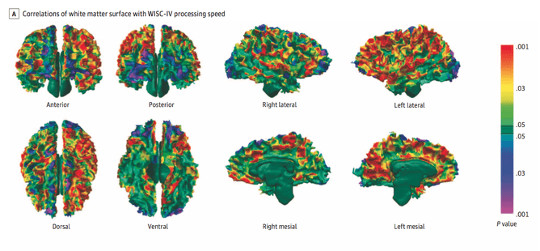
Exposure to air pollutants during pregnancy may contribute to childhood abnormalities in the brain, a new study suggests.
The research, from the Children’s Hospital of Los Angeles, measured the exposure of the mothers to PAH air pollution and used brain imaging to look at the effects on their children’s brains.
PAHs, or polycyclic aromatic hydrocarbons, are widespread pollutants formed when organic materials are incompletely burned. They originate from vehicle exhausts, burning coal and oil, waste incineration, and wildfires. They can also be found inside the home, for example from tobacco smoke or open fires and stoves.
We Need Our White Matter
The researchers began looking at the effects of prenatal exposure to PAH on brain development in the 1990s. The initial study recruited more than 600 women in the third trimester of pregnancy from New York City minority communities. They completed questionnaires and were given portable pollution monitors for 48 hours to allow researchers to determine their exposure.
Their children were then assessed between the ages of three and seven, and the team found that exposure was associated with symptoms of ADHD (attention deficit hyperactivity disorder) and other cognitive and behavioural problems including reduced IQ, anxiety and depression.
For the latest study, 40 of the same children had their brains scanned, revealing a strong link between PAH exposure in the womb and a reduction of white matter in the brain. Brain white matter is made of millions of cells called axons that allow rapid connections between different regions of the brain.
 The study found an association of areas of reduced white matter with the processing speed of that part of the brain. Yellow, red and orange show areas where white matter had affected the processing speed of that part of the brain. There was a stronger correlation in the left side of the brain. from Peterson et al. 2015, JAMA Psychiatry, Author providedWhat’s more, these disturbances in the brain were associated with slower reaction times during intelligent testing as well as more severe ADHD symptoms and conduct disorder.
The study found an association of areas of reduced white matter with the processing speed of that part of the brain. Yellow, red and orange show areas where white matter had affected the processing speed of that part of the brain. There was a stronger correlation in the left side of the brain. from Peterson et al. 2015, JAMA Psychiatry, Author providedWhat’s more, these disturbances in the brain were associated with slower reaction times during intelligent testing as well as more severe ADHD symptoms and conduct disorder.
Growing Signs Of Trouble
This study’s findings add to a growing body of literature on air pollution and health, from which other studies report associations with autism spectrum disorders, schizophrenia and cognitive impairment.
For example, one study of Californian children showed that those exposed to the highest levels of traffic-related air pollution during pregnancy and in the first year of life were more likely to develop autistic spectrum disorders than those exposed to the lowest levels.
More direct evidence that air pollution affects the developing brain comes from animal studies. One study of the brains of young mice exposed to ultra-fine particles at concentrations similar to those found in rush-hour traffic found the mice displayed enlarged cavities in their brains – a condition which in humans is associated with autism and schizophrenia.
Particles – Bad News For The Brain
The mechanism by which air pollution is toxic to the brain is not yet fully understood, in particular, the pathway to the brain of particulate matter (PM) – small pollutants particles which can carry PAHs on their surface.
Ultrafine particles are believed to move to the brain either by travelling from the lung into the systemic circulation and across the blood brain barrier or by landing at the back of the nose then travelling to the brain via the olfactory nerve. Once in the brain, pollutant particles can cause inflammation and cellular damage.
Need For More Research
As with any scientific project, there were limitations to the study: the sample size was small and it was not possible to exclude the possibility that the findings could have been caused by other environmental exposures. The researchers plan to scan many more children, and to assess the way PAH interact with other contaminants and their effects on the brain.
It’s also important to remember that the findings were made from a study of a specific population with a high level of poverty, low educational attainment and below-average maternal IQ – so the results may not easily generalise to other populations.
This study and much of the other research on air pollution and the brain originates from the US, where the proportion of one major source of urban air pollution – the diesel-powered car – is low compared to the UK. This makes it necessary to collect our own data here.
In our recently launched birth cohort study we will be collecting detailed information on 80,000 UK babies and their parents during pregnancy and the first year of children’s lives to work out which factors shape growth, development, health and well-being.
The Cost Of Air Pollution
Although there has been relatively little research on the negative effects of air pollution on the nervous system, evidence is already mounting. A unique feature of air pollution as a risk factor for disease is that exposure is almost universal.
Importantly, the study showed that the more the mother was exposed to PAH while pregnant, the larger the white matter disturbance in the child. This suggests that reduction in exposure to PAHs during pregnancy and just after birth has the potential to bring about an equivalent reduction in white matter disturbance in the child’s brain and its effects.
If further studies find similar results, the public health implications are significant given how widespread PAHs are and how little we know about the causes of mental health problems – an area that presents a large and growing disease burden on society.
The ever-accumulating evidence that so many components of air pollution contribute to such a diverse set of diseases confirms the urgent need to manage the quality of the air we breathe. Achieving this promises to be a significant and cost-effective way of improving our health and quality of life.
![]() This article was originally published on The Conversation
This article was originally published on The Conversation
Read the original article.
About The Authors
 Frank Kelly is a Professor of Environmental Health at King's College London. His research focuses on how the lung defends itself from the challenges of pollution and why, for some of us, these defences sometimes fail. Much of his current work examines the oxidant mechanisms underlying air pollution-induced lung injury.
Frank Kelly is a Professor of Environmental Health at King's College London. His research focuses on how the lung defends itself from the challenges of pollution and why, for some of us, these defences sometimes fail. Much of his current work examines the oxidant mechanisms underlying air pollution-induced lung injury.
 Julia Kelly is a scientific communicator within the Environmental Research Group at King’s College London. Here she disseminates key research outcomes and findings on the health effects of air pollution through the preparation of a wide range of written material.
Julia Kelly is a scientific communicator within the Environmental Research Group at King’s College London. Here she disseminates key research outcomes and findings on the health effects of air pollution through the preparation of a wide range of written material.






















